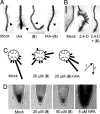Small-molecule agonists and antagonists of F-box protein-substrate interactions in auxin perception and signaling
- PMID: 18391211
- PMCID: PMC2291130
- DOI: 10.1073/pnas.0711146105
Small-molecule agonists and antagonists of F-box protein-substrate interactions in auxin perception and signaling
Abstract
The regulation of gene expression by the hormone auxin is a crucial mechanism in plant development. We have shown that the Arabidopsis F-box protein TIR1 is a receptor for auxin, and our recent structural work has revealed the molecular mechanism of auxin perception. TIR1 is the substrate receptor of the ubiquitin-ligase complex SCF(TIR1). Auxin binding enhances the interaction between TIR1 and its substrates, the Aux/IAA repressors, thereby promoting the ubiquitination and degradation of Aux/IAAs, altering the expression of hundreds of genes. TIR1 is the prototype of a new class of hormone receptor and the first example of an SCF ubiquitin-ligase modulated by a small molecule. Here, we describe the design, synthesis, and characterization of a series of auxin agonists and antagonists. We show these molecules are specific to TIR1-mediated events in Arabidopsis, and their mode of action in binding to TIR1 is confirmed by x-ray crystallographic analysis. Further, we demonstrate the utility of these probes for the analysis of TIR1-mediated auxin signaling in the moss Physcomitrella patens. Our work not only provides a useful tool for plant chemical biology but also demonstrates an example of a specific small-molecule inhibitor of F-box protein-substrate recruitment. Substrate recognition and subsequent ubiquitination by SCF-type ubiquitin ligases are central to many cellular processes in eukaryotes, and ubiquitin-ligase function is affected in several human diseases. Our work supports the idea that it may be possible to design small-molecule agents to modulate ubiquitin-ligase function therapeutically.
Conflict of interest statement
The authors declare no conflict of interest.
Figures






Similar articles
-
Auxin-induced, SCF(TIR1)-mediated poly-ubiquitination marks AUX/IAA proteins for degradation.Plant J. 2009 Jul;59(1):100-9. doi: 10.1111/j.1365-313X.2009.03854.x. Epub 2009 Feb 26. Plant J. 2009. PMID: 19309453
-
Mechanism of auxin perception by the TIR1 ubiquitin ligase.Nature. 2007 Apr 5;446(7136):640-5. doi: 10.1038/nature05731. Nature. 2007. PMID: 17410169
-
The F-box protein TIR1 is an auxin receptor.Nature. 2005 May 26;435(7041):441-5. doi: 10.1038/nature03543. Nature. 2005. PMID: 15917797
-
Auxin receptors and plant development: a new signaling paradigm.Annu Rev Cell Dev Biol. 2008;24:55-80. doi: 10.1146/annurev.cellbio.23.090506.123214. Annu Rev Cell Dev Biol. 2008. PMID: 18631113 Review.
-
Auxin receptors: a new role for F-box proteins.Curr Opin Cell Biol. 2006 Apr;18(2):152-6. doi: 10.1016/j.ceb.2006.02.001. Epub 2006 Feb 17. Curr Opin Cell Biol. 2006. PMID: 16488128 Review.
Cited by
-
Auxin Regulates Apical Stem Cell Regeneration and Tip Growth in the Marine Red Alga Neopyropia yezoensis.Cells. 2022 Aug 26;11(17):2652. doi: 10.3390/cells11172652. Cells. 2022. PMID: 36078060 Free PMC article.
-
Auxin distribution and lenticel formation in determinate nodule of Lotus japonicus.Plant Signal Behav. 2011 Sep;6(9):1405-7. doi: 10.4161/psb.6.9.16934. Plant Signal Behav. 2011. PMID: 22019641 Free PMC article.
-
SCFTIR1 /AFB Auxin Signaling for Bending Termination during Shoot Gravitropism.Plant Physiol. 2020 May;183(1):37-40. doi: 10.1104/pp.20.00212. Epub 2020 Feb 27. Plant Physiol. 2020. PMID: 32107280 Free PMC article.
-
Rational design of a ligand-based antagonist of jasmonate perception.Nat Chem Biol. 2014 Aug;10(8):671-6. doi: 10.1038/nchembio.1575. Epub 2014 Jul 6. Nat Chem Biol. 2014. PMID: 24997606
-
Plant hormone receptors: new perceptions.Genes Dev. 2008 Aug 15;22(16):2139-48. doi: 10.1101/gad.1693208. Genes Dev. 2008. PMID: 18708574 Free PMC article. Review.
References
-
- Dharmasiri N, Dharmasiri S, Estelle M. The F-box protein TIR1 is an auxin receptor. Nature. 2005;435:441–445. - PubMed
-
- Kepinski S, Leyser O. The Arabidopsis F-box protein TIR1 is an auxin receptor. Nature. 2005;435:446–451. - PubMed
-
- Dharmasiri N, et al. Plant development is regulated by a family of auxin receptor F box proteins. Dev Cell. 2005;9:109–119. - PubMed
-
- Kepinski S. The anatomy of auxin perception. BioEssays. 2007;29:953–956. - PubMed
Publication types
MeSH terms
Substances
Associated data
- Actions
- Actions
- Actions
Grants and funding
LinkOut - more resources
Full Text Sources
Other Literature Sources
Molecular Biology Databases

